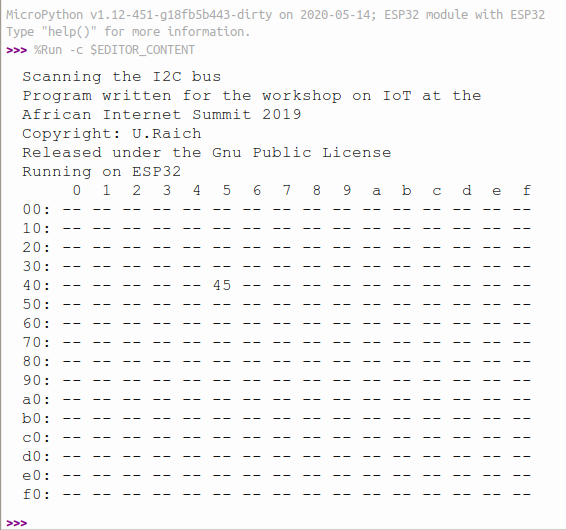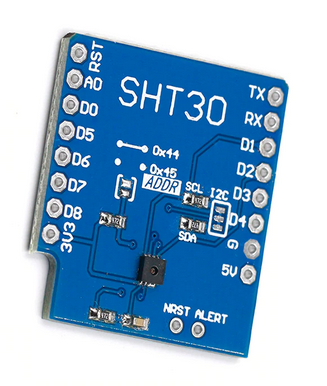
Difference: TheI2CBusAndTheSHT30TemperatureAndHumiditySensor (2 vs. 3)
Revision 32020-05-17 - UliRaich
| Line: 1 to 1 | ||||||||
|---|---|---|---|---|---|---|---|---|
Exercise 5: The I2C bus and the SHT30 Temperature and Humidity SensorIntroduction | ||||||||
| Changed: | ||||||||
| < < | While the DHT11 uses a proprietary protocol the SHT30 make use of a standardized protocol: the I2C protocol, invented by Philips at the beginning of the 1980's. To get you going with I2C please have a look at https://learn.sparkfun.com/tutorials/i2c/all | |||||||
| > > | While the DHT11 uses a proprietary protocol the SHT30 make use of a standardized protocol: the I2C protocol, invented by Philips at the beginning of the 1980's. To get you going with I2C please have a look at https://learn.sparkfun.com/tutorials/i2c/all | |||||||
Exercise 1: I2C Bus ScanI2C is supported by a driver in the MicroPython | ||||||||
| Added: | ||||||||
| > > | The ESP32 has 2 hardware I2C interfaces (bus 0 and bus 1) with GPIO 21 connected to SDA and GPIO 22 connected to SCL of bus1. | |||||||
Write a script that scans the I2C bus and prints all available I2C addresses in the following form:
 | ||||||||
| Line: 20 to 20 | ||||||||
|
First of all let's have a look at the SHT30 documentation | ||||||||
| Changed: | ||||||||
| < < | This time we are going to be lazy and just use a pure Python driver written by 'Roberto Sánchez which you can find on github at https://github.com/rsc1975/micropython-sht30/blob/master/sht30.py | |||||||
| > > |  This time we are going to be lazy (?) and just use a pure Python driver written by 'Roberto Sánchez which you can find on github at https://github.com/rsc1975/micropython-sht30/blob/master/sht30.py
This time we are going to be lazy (?) and just use a pure Python driver written by 'Roberto Sánchez which you can find on github at https://github.com/rsc1975/micropython-sht30/blob/master/sht30.py | |||||||
| Changed: | ||||||||
| < < | I will give no further explication on how to use the driver. Please read the source code and find out yourself which methods are implemented and how to use the driver. Does it work out of the box or do we have to make some modifications? | |||||||
| > > | I will give no further explication on how to use the driver. Please read the source code and find out yourself which methods are implemented and how to use the driver. Does it work out of the box or do we have to make some modifications? Do you find bugs? | |||||||
| The driver is already hard-coded in the MicroPython binary and does not need to be uploaded to the ESP32 to be used. | ||||||||
| Line: 37 to 39 | ||||||||
| ||||||||
| Added: | ||||||||
| > > |
| |||||||
View topic | History: r13 < r12 < r11 < r10 | More topic actions...
Ideas, requests, problems regarding TWiki? Send feedback